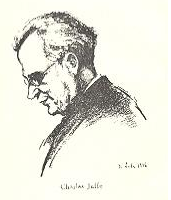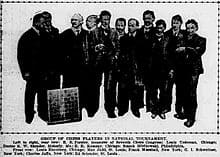
- Chess World Cup
- FIDE Grand Prix
- Olympiad
- World Championship
- List of strong tournaments
- List of world championships

- Checkmate patterns
- Chess openings
- Chess strategy
- Chess tactics
- Chess theory
- Endgames
- Pawn structure
- Problems/Compositions












 Jaffe's portrait from Jaffe’s Chess Primer (1937)
Jaffe's portrait from Jaffe’s Chess Primer (1937)Charles Jaffé (Jaffe) (circa 1879, Dubroŭna, Belarus - 12 July 1941, Brooklyn, USA) was a Belarusian-American chess master. Jaffe was also a chess writer.
Jaffé was born in a small town, Dubroŭna (now in Vitsebsk Voblast), Belarus (then Russian Empire). Considerable doubt exists as to his precise birthdate, as raised by chess historian Edward Winter and others. Various sources list his birthdate anywhere between 1876 and 1887. Jaffe emigrated to the United States in 1896, and settled in New York City. He worked as a silk-mill merchant until he became a professional chess player in 1910.
 Jaffe as part of a group photo at the St. Louis tournament, 1904
Jaffe as part of a group photo at the St. Louis tournament, 1904In 1904, he took 7th out of 10 players at the St. Louis (7th American Congress) with 5/11, as Frank James Marshall won. Jaffe defeated Jacques Mieses, a leading player, by 2-0 in a mini-match at New York 1907. In 1909, Jaffe took 3rd out of 6 players with 3/5 in a small tournament at Bath Beach, Brooklyn NY (Herbert Rosenfeld won). Also in 1909, Jaffe lost a match to Frank Marshall by a score 3.5-5.5 (+2 =3 -4). In 1911, he tied for 3rd-4th at New York, with 9/12 (Marshall won). After this career-best result, Charles Jaffe made his international debut at the Carlsbad 1911 chess tournament. There, he tied for 23rd-26th, with 8.5/25, out of 26 players. (Richard Teichmann won) In 1913, he took 3rd at New York (National), with 9.5/13, behind José Raúl Capablanca and Marshall. In 1913, he lost a match to Capablanca at New York by 0.5-2.5. In a later New York tournament that same year, Jaffe scored 0.5/6 to finish 4th out of 4 players, as Marshall won.
Jaffe was nicknamed "the Crown Prince of East Side Chess" by the poet and chessmaster Alfred Kreymborg. He often played at the Stuyvesant Chess Club, hangout of chess hustlers and interesting characters, which had many strong players, and was located on Manhattan's Lower East Side. "Jaffe was famous for his poverty", and "his style was "inimitably coffeehouse". Jaffe made much of his income through challenge games and odds games played there. The colorful atmosphere of the Club in that era was outlined by in the book The Bobby Fischer I Knew And Other Stories.
Jaffe became involved in a 1916 court battle involving the non-inclusion for publication of some of his chess analysis of the King's Gambit, Rice Gambit, but he lost the case, despite being supported by witnesses who included U.S. champion Frank Marshall. This was apparently the first American case where chess matters made it to the courts. While seemingly frivolous, this case should be viewed from the perspective of Jaffe making much of his living from writing articles on chess for Jewish periodicals, so his professional reputation was at stake.
In 1916, Jaffe narrowly lost a match (+4 =4 -5) to David Janowski. Then in 1917-1918, he played a return match against Janowski, this time losing by a score of (+4 =4 -10). In 1918, Jaffe tied for 3rd-5th at Rye Beach, New York (Abraham Kupchik won). In 1922, he took 2nd, behind Edward Lasker, in New York (CCI). In 1925, he took 3rd in Cedar Point, Ohio (Kupchik won). In 1926, he tied for 4-5th at Chicago (Marshall won). In 1926, he took 2nd, behind Kupchik, at New York (Quadrangular).
In 1927, Jaffe sent a cable from New York to Alexander Alekhine in Buenos Aires, where Alekhine was playing José Raúl Capablanca in the World Championship match. The cable contained Jaffe's analysis of a new variation in the Queen's Gambit, which Alekhine is thought to have used in the match. The victorious Alekhine, upon returning to New York, played a two-game match against Jaffe at the Waldorf-Astoria Hotel, without financial remuneration, as a favour to Jaffe, and won both games.
Jaffe then left most competitive chess for a decade, except for occasional forays into Metropolitan League play in the mid-1930s, where he defeated a young (but already very strong) Reuben Fine in 1934. Jaffe lost a 1930 match at New York to Isaac Kashdan by 0-3; Kashdan was the top player in the United States at this time. Jaffe wrote Jaffe's Chess Primer in 1937 (published by Parnassus). His health was in decline by this stage. Jaffe also published several works in Yiddish. His return to chess in later life was chronicled by the writer and chess master Alfred Kreymborg in the short story Chess Reclaims a Devotee. Jaffe did qualify for the finals at the 1938 U.S. Open Chess Championship at Boston, where he finished tied 8-9th with 4/11, as Al Horowitz won. Jaffe's final tournament was the 1939 U.S. Open Chess Championship at New York, where he qualified for the finals, but lost all 11 of his games in that group to place 12th, as Reuben Fine won.